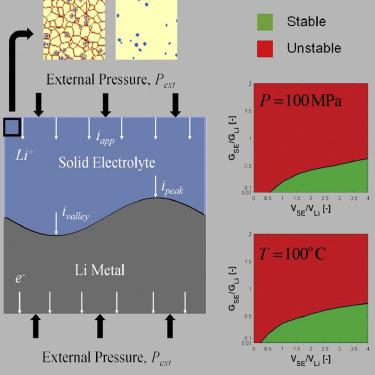Cell Reports Physical Science ( IF 7.9 ) Pub Date : 2021-01-07 , DOI: 10.1016/j.xcrp.2020.100301 Ankit Verma , Hiroki Kawakami , Hiroyuki Wada , Anna Hirowatari , Nobuhisa Ikeda , Yoshifumi Mizuno , Toshikazu Kotaka , Koichiro Aotani , Yuichiro Tabuchi , Partha P. Mukherjee

|
Interfacial deposition stability at the Li-metal-solid electrolyte interface in all solid-state batteries is governed by the stress-transport-electrochemistry coupling in conjunction with the polycrystalline/amorphous solid electrolyte architecture. In this work, we delineate the optimal solid electrolyte microstructure comprising grains, grain boundaries, and voids possessing desirable ionic conductivity and elastic modulus for superior transport and strength. An analytical formalism is provided to discern the impact of external “stack” pressure-induced mechanical stress on electrodeposition stability; the stress magnitudes obtained are in the megapascal range, considerably diminishing the stress-kinetics effects. For experimental stack pressures ranging up to 10 MPa, the impact of stress on reaction kinetics is negligibly small, and electrolyte transport overpotentials dictate electrodeposition stability. High current density operation with stable deposition can be ensured with ample external pressure, high temperature, and low surface roughness operation for a low shear modulus ratio of the solid electrolyte to Li-metal.
中文翻译:

固态电池的微观结构和压力驱动电沉积稳定性
在所有固态电池中,锂-金属-固体电解质界面处的界面沉积稳定性取决于应力传输-电化学耦合以及多晶/非晶态固体电解质的结构。在这项工作中,我们描述了最佳的固体电解质微观结构,包括晶粒,晶界和空隙,这些空隙具有理想的离子电导率和弹性模量,从而具有出色的传输和强度。提供了一种分析形式,以辨别外部“堆”压力引起的机械应力对电沉积稳定性的影响;获得的应力大小在兆帕范围内,大大降低了应力动力学效应。对于最高10 MPa的实验烟囱压力,应力对反应动力学的影响可以忽略不计,电解液的超电势决定了电沉积的稳定性。在固体电解质与锂金属的剪切模量比低的情况下,在足够大的外部压力,高温和低表面粗糙度的情况下,可以确保具有稳定沉积的高电流密度操作。











































 京公网安备 11010802027423号
京公网安备 11010802027423号